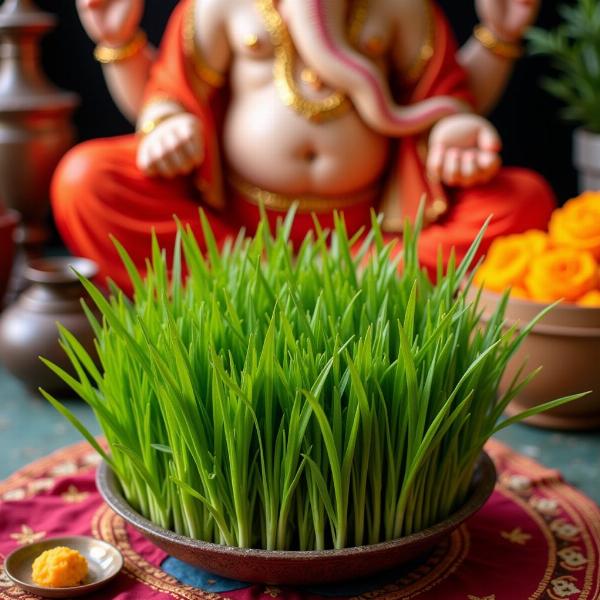Understanding the meaning of “grass” in Hindi goes beyond a simple translation. It delves into cultural nuances, literary symbolism, and everyday usage. This guide explores the various meanings of “grass” in Hindi, its significance in Indian culture, and provides practical examples to help you grasp its full context.
Exploring the Hindi Translations of “Grass”
The most common Hindi word for “grass” is “घास” (ghaas). However, depending on the context, other words can be used to convey a more specific meaning. For instance, “तृण” (tr̥ṇa) is a more formal and literary term for grass, often used in religious or poetic contexts. Another word, “हरियाली” (hariyali), refers to greenery or vegetation, encompassing more than just grass. This nuanced vocabulary reflects the importance of nature in Indian culture.
Cultural Significance of Grass in India
Grass plays a significant role in various Indian traditions and beliefs. In Hinduism, grass is considered sacred and is often used in religious ceremonies. For example, “Durva grass” (दूर्वा) is offered to Lord Ganesha. The vibrant green of grass also symbolizes prosperity and auspiciousness.  Grass in Indian Culture Furthermore, the image of cows grazing on lush green pastures is a common idyllic scene in rural India, representing harmony between nature and human life.
Grass in Indian Culture Furthermore, the image of cows grazing on lush green pastures is a common idyllic scene in rural India, representing harmony between nature and human life.
Different Contexts, Different Meanings
The meaning of “grass” can vary depending on the context. Consider the following examples:
- “Cutting the grass”: In Hindi, this would be translated as “घास काटना” (ghaas kaatna).
- “A blade of grass”: This can be translated as “घास का एक तिनका” (ghaas ka ek tinka) or simply “तिनका” (tinka). a blade of grass meaning in hindi provides further insight into this.
- “Let the grass grow under one’s feet”: This idiom, implying inactivity, doesn’t have a direct equivalent in Hindi but can be expressed using phrases like “समय बर्बाद करना” (samay barbaad karna) which means “to waste time.”
Grass in Hindi Literature and Poetry
Grass frequently appears in Hindi literature and poetry, often symbolizing life, growth, and resilience. Its simple beauty and connection to nature make it a powerful metaphor. Poets often use grass to evoke feelings of peace, tranquility, and nostalgia.
Common Questions about Grass in Hindi
What is the word for “grassland” in Hindi? The word for grassland in Hindi is “घास का मैदान” (ghaas ka maidan) or simply “मैदान” (maidan). steppes meaning in hindi might also be relevant depending on the type of grassland.
How do you say “grasshopper” in Hindi? The word for grasshopper in Hindi is “टिड्डा” (tidda). grasshopper in hindi meaning provides a more detailed explanation.
Practical Applications and Uses of Grass
Beyond its symbolic meaning, grass has numerous practical applications in India. It’s used as fodder for livestock, in construction, and even in traditional medicine. The versatility of grass underscores its integral role in Indian life.
Lemongrass: A Special Case
While not strictly “grass,” lemongrass deserves a mention. Known as “लेमन ग्रास” (lemon grass) in Hindi, it’s a popular herb used in cuisine and traditional medicine. You can learn more about it at lemongrass meaning in hindi. blade of grass meaning in hindi further expands on different types of grasses and their meanings.
Conclusion
Understanding the meaning of “grass” in Hindi offers a glimpse into the rich cultural tapestry of India. From its religious significance to its practical applications and poetic symbolism, “grass” transcends a simple botanical definition. This exploration of “grass meaning in hindi” unveils the depth and nuance of the Hindi language and its connection to the natural world.
- What are the different Hindi words for “grass”? The common word is “घास” (ghaas), while “तृण” (tr̥ṇa) is used in formal and literary contexts. “हरियाली” (hariyali) refers to broader greenery.
- Why is grass important in Indian culture? Grass holds religious significance, is used in ceremonies, and symbolizes prosperity.
- How do you say “blade of grass” in Hindi? It’s translated as “घास का एक तिनका” (ghaas ka ek tinka) or “तिनका” (tinka).
- What are some practical uses of grass in India? Grass serves as fodder, is used in construction and traditional medicine.
- What is the Hindi word for “lemongrass”? It’s “लेमन ग्रास” (lemon grass).
- Where can I learn more about the meaning of specific types of grass? Check out articles like blade of grass meaning in hindi.
- What does “grassland” mean in Hindi? It’s “घास का मैदान” (ghaas ka maidan) or “मैदान” (maidan).
Meaning-Hindi.in is your trusted partner for professional Hindi translation services. We specialize in business, legal, technical, website localization, educational, and specialized translations. Our team of expert linguists ensures accurate and culturally sensitive translations that meet your specific needs. For high-quality Hindi translation services, contact us at [email protected] or call us at +91 11-4502-7584. Meaning-Hindi.in is dedicated to bridging language barriers and fostering clear communication.